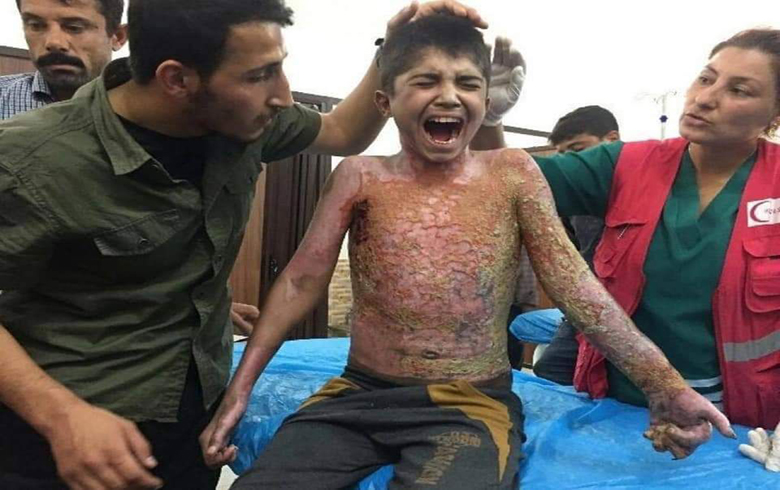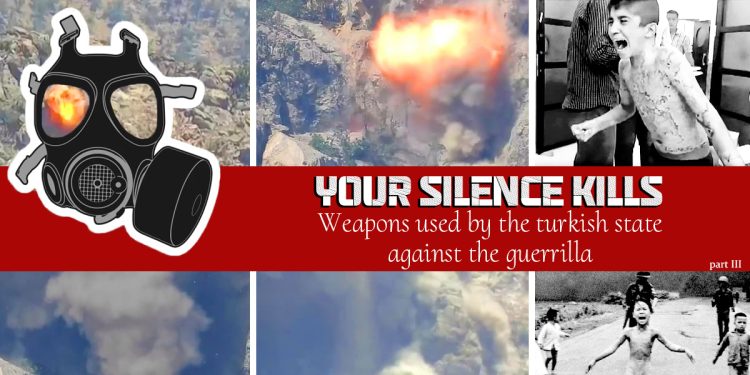NEWS CENTER – In the third section of our dossier “Your Silence Kills” in which we dealt with the committed war crimes of the Turkish occupying state, we will go into more detail about the combat agents that the Turkish occupying soldiers used according to the HPG. Since there are a variety of chemical warfare agents, missiles with chemical agents, nuclear weapons and phosphorus bombs, we have limited ourselves to a certain selection in order to make clear the history of origin, effect and use of these weapons in history. It is a rough overview that clearly shows what hegemonic states and especially the fascist mentality of domination are capable of in history and until today. How weapons are invented, produced and used, without any human emotion of decency or conscience, in full knowledge that these weapons will lead to cruel massacres of humanity in the future.
What was invented and developed in the centers of fascist ruling states was used especially against insurgent and rebellious peoples, against minorities and oppressed groups, as well as against revolutionary associations. This is particularly evident in the confrontation with these weapons. Whether today or in the past, Kurdistan has always been the scene of these cruel massacres, in which those in power wanted to enforce their lust for power through massacres and destruction. Yesterday, as today, these weapons have been used against the resistant Kurdish people, without the responsible parties ever being held seriously accountable.
In the following section, we will discuss incendiary bombs, i.e. phosphorus bombs and napalm, and in tomorrow’s section we will deal with the various forms of chemical weapons. We will then discuss thermobaric bombs and tactical nuclear bombs, concluding the third section of this dossier.
3. WEAPONS USED
3.1 Incendiary bombs
Incendiary bombs are weapons used to set materials or objects on fire by the action of flame, heat, or their cobination, or to inflict massive burn injuries on people.
Incendiary bombs contain various incendiaries (such as phosphorus and napalm) that are usually difficult to extinguish and burn at very high temperatures. The incendiaries are effectively spread over as large an area as possible by means of the bombs when they are dropped. These weapons are outlawed over conventional weapons because they cause excessive suffering to those affected and have been regulated by the 1983 Convention on Certain Conventional Weapons.
3.1.1 Phosphorus bombs
During the invasion operation of the Turkish occupying state, which started on April 14 this year and aims to destroy the Kurdistan freedom struggle, the HPG reported the use of banned phosphorus bombs several times.
On July 11, 2022, the HPG reported for the first time that phosphorus bombs were used against the resistance areas and stated:
- “On July 10 at 12:50 p.m., the Turkish occupation army bombed the fighting positions in the Şikefta Birîndara resistance area with phosphorus bombs and explosives.”
Following this report, the attacks with phosphorus bombs on the resistance area of Şikefta Birîndara were intensified. On July 12, this weapon was used again, and on July 13, the war tunnels in the Şikefta Birîndara resistance area were again victims of the use of phosphorus bombs. On July 19, again the resistance area was attacked twice with phosphorus. Also on July 20 and July 21, phosphorus bombs were used by the Turkish occupying state against the freedom guerrillas in the resistance areas.
On August 9, 2022, the HPG reported that phosphorus bombs were also used against the Girê FM war tunnels in the Girê Cûdî resistance area. The August 21, 2022 HPG report revealed that on August 20, the Şikefta Birîndara resistance area was bombed three times with phosphorus bombs. On August 21, 2022, the attacks were taken to the extreme, as the HPG reported on August 22, the areas were bombed 26 times with phosphorus bombs.
But what does this actually mean when this weapon is used against the guerrillas? What is the impact of this weapon on people and the environment? To explore these questions and more, we took a closer look at this weapon:
HISTORY
The incendiary and smoke effect of white phosphorus was already discovered and used in warfare during the First World War. However, this weapon was not used on a large scale until the Second World War, in the form of incendiary bombs. The German version of the incendiary bomb is called “C50 A” and “C250 A”, the British version “INC 30 ib” and itself contains only a small amount of phsophore which is used as a fuse for the incendiary mass. Another version is the British smoke bomb “Bomb Smoke 100lb” which contains 40 kg of phosphorus solution which serves as “incendiary mass” for the bomb. The American Air Force mainly used the “AN-M47”, a 45 kg phosphorus bomb. In the then Soviet Union, the so-called “Ash-2” was used as an incendiary bomb.
According to official information, incendiary bombs (DIME bombs: Dense Inert Metal Explosive) were used by the Israel Defense Forces in the Lebanon War in 2006, whose injury pattern resembles phosphorus bombs but is made of a tungsten-copper-aluminum mixture. In Gaza, phosphorus bombs were used in the Israeli army’s 2009 “Operation Cast Lead,” in which the Israeli army shelled the headquarters of the UN Relief and Works Agency and a UN school for refugees with phosphorus shells. Israel itself confirmed the operation in Gaza.
Phosphorus bombs were used in Reqqa, Syria, by Russian airstrikes on November 13, 2015, and the Iraqi military also reportedly used phosphorus bombs in the liberation of Mosul in the summer of 2017. Turkish occupation forces used phosphorus bombs against QSD forces during an occupation offensive against Rojava, in northeastern Syria.
Dr. Abbas Mansouran, a volunteer medic who has been working in hospitals in the North-East Kurdistan region to investigate whether chemicals were used in the Turkish state’s invasion attacks on Efrîn, Serêkaniyê and Girê Spî, spoke to Mesopotamia Agency (MA) about the issue. He stressed during the conversation that phosphorus bombs were used by the Turkish soldiers in the areas and said:
“The invasion of Efrîn and Serêkaniyê would have been impossible if Turkey had not used these bombs. (…) Turkey used this gas in 2019 in the cities and countryside of Serêkaniyê and Girê Spî. (…) White phosphorus is also used in a variety of munitions and devices for different purposes. Regardless of which phosphorus munitions are used against people, they are classified as chemical weapons.”
Mansouran said that at the end of his time in northeastern Syria, the Rojava Human Rights Defenders Initiative produced a 19-page report, which it announced with a statement in Paris and submitted to the International Commission on Human Rights on Jan. 10, 2020. Mansouran pointed out that the report’s scientific research was conducted in Swedish laboratories. The results showed that Turkey used white phosphorus in the invasion attacks on Serêkaniyê in October 2019.

(Source: https://rojnews.news/tr/kurdistan/dr-abbas-mansouran-kdpnin-engellemeleri-opcwye-kanitlar-sunmayi-zorlastiriyor/)
During Russia’s current invasion of Ukraine, Russia allegedly attacked with phosphorus munitions in the locality of Popasna on March 13, 2022. In addition, phosphorus bombs are alleged to have been dropped against the locality of Rubishne, as well as on the Azov Steel Plant in Mariupol and Snake Island. However, the allegations have so far been substantiated only with poorly verifiable videos.
EFFECT
Phosphorus bombs consist of a mixture of white phosphorus and rubber and are also known as smoke bombs.
White phosphorus is the most reactive modification of phosphorus and self-ignites on contact with air or oxygen. The flame burns with a heat of 1300 degrees Celsius and develops strong white smoke.
Even skin contact with small amounts of white phosphorus causes third degree burns, (some down to the bone) which are difficult to heal. In addition, white phosphorus and its fumes are highly toxic. Ingestion of as little as 50mg are fatal to an adult human, with death from the poison occurring after 5-10 days. However, the risk of poisoning by white phosphorus through the skin is lower.
However, when phosphorus bombs are involved, the white phosphorus mixes with the rubber and becomes a viscous mass that sticks to the skin and spreads when an attempt is made to knock out the burn areas. Often in attacks with phosphorus bombs, the burns on the affected people are extensive, causing them to die slowly from their burns, if they did not die from inhalation of the toxic fumes, respiratory burns.
PROHIBITION
The 1977 Additional Protocols to the 1949 Geneva Conventions prohibited the use of incendiary weapons against civilians. (Source: Wikipedia.de; https://thekurdishproject.org/history-and-culture/kurdish-history/kurdistan-genocide/; https://www.voanews.com/a/kurds-accuse-turks-of-dropping-napalm/4228316.html)




